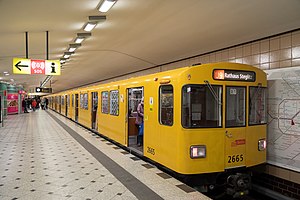You can help expand this article with text translated from the corresponding article in German. (March 2022) Click [show] for important translation instructions.
|
| BVG Class F | |
|---|---|
 An F79 train at Zoologischer Garten on the U9 | |
 Interior of an F87 train (before refurbishment) | |
| In service | 1973–present |
| Manufacturer | ABB Henschel, Adtranz, AEG, Orenstein & Koppel, Siemens, Waggon Union |
| Constructed | 1973–1994 |
| Entered service |
|
| Refurbished |
|
| Scrapped |
|
| Number built | 257 |
| Number in service | 208 |
| Number preserved | 3 |
| Number scrapped | 46 5 (F74) 1 (F76) 17 (F79.1) 19 (F79.2) 4 (F79.3) |
| Formation | Double units |
| Fleet numbers | 2500/01–2554/55 (F74) 2556/57–2636/37 (F76) 2638/39–2670/1 (F79.1) 2672/73–2710/11 (F79.2) 2712/13–2722/23 (F79.3) 2724/25–2800/01 (F84) 2802/03–2842/43 (F87) 2844/45–2902/03 (F90) 2904/05–3012/13 (F92) |
| Capacity | 235 (F74, F76) 250 (F79.1, F79.2) 246 (F79.3) 244 (F84–F92) |
| Operators | Berliner Verkehrsbetriebe |
| Lines served | U5, U6, U7, U8 and U9 |
| Specifications | |
| Car body construction | Aluminium |
| Train length | 32.1 m (105 ft 3+3⁄4 in) (over anticlimbers) |
| Width | 2.65 m (8 ft 8+5⁄16 in) |
| Height | 3.425 m (11 ft 2+13⁄16 in) |
| Doors | 12 side doors per unit (6 per side) |
| Maximum speed | 72 kilometres per hour (45 mph) |
| Weight | F74: 38,100 kg (83,996 lb) F76: 37,800 kg (83,335 lb) |
| Prime mover(s) | Electric motor |
| Electric system(s) | 750 V DC third rail |
| Current collector(s) | Contact shoe |
| Safety system(s) | Dead man's switch, Magnetic train stop |
| Coupling system | Scharfenberg |
The BVG Class F is a train type designed for the large profile routes on the Berlin U-Bahn. 257 units (each consisting of two cars) were constructed between 1973 and 1994 in seven batches. These batches differ in terms of design and technical equipment.
The prototype unit 2500/01 underwent testing from 1973 on. After successful trial runs, regular production started the year after. 112 double units (batches F74 to F79) were delivered to West Berlin until the end of 1981, replacing the remainder of the pre-war Class C. 145 additional units, featuring various improvements, were built between 1984 and 1994 and partly replaced trains from the former East Berlin network after the German reunification.
Being built from 1995 to 2002 the BVG Class H became the successor of the Class F.